Which of the following is true of Amazon EBS encryption keys?
D
Amazon EBS encryption uses AWS Key Management Service (AWS KMS) master keys when creating encrypted volumes and any snapshots created from your encrypted volumes.
Reference:
http://docs.aws.amazon.com/AWSEC2/latest/UserGuide/AmazonEBS.html
A user is creating a snapshot of an EBS volume. Which of the below statements is incorrect in relation to the creation of an EBS snapshot?
D
The EBS snapshots are a point in time backup of the EBS volume. It is an incremental snapshot, but is always specific to the region and never specific to a single
AZ. Hence the statement "It is stored in the same AZ as the volume" is incorrect.
Reference:
http://docs.aws.amazon.com/AWSEC2/latest/UserGuide/EBSSnapshots.html
A user is running a critical batch process which runs for 1 hour and 50 mins every day at a fixed time. Which of the below mentioned options is the right instance type and costing model in this case if the user performs the same task for the whole year?
D
For Amazon Web Services, the reserved instance (standard or convertible) helps the user save money if the user is going to run the same instance for a longer period. Generally, if the user uses the instances around 30-40% of the year annually it is recommended to use RI. Here as the instance runs only for 1 hour 50 minutes daily, or less than 8 percent of the year, it is not recommended to have RI as it will be costlier. At its highest potential savings, you are still paying 25 percent of an annual cost for a reserved instance you are you using less than 2 hours a day, (or less than 8 percent of each year) you are not saving money. Even a scheduled reserved instance has a key limitation, which is that it cannot be stopped or rebooted, only manually terminated with a possibility that it could be restarted. You would have to terminate and restart it within the 1 hour 50-minute window, otherwise you would need to wait until the next day. For a critical daily process, this is likely not an option. Spot Instances are not ideal because the process is critical, and must run for a fixed length of time at a fixed time of day. Spot instances would stop and start based on fluctuations in instance pricing, leaving this process potentially unfinished. The user should use on-demand with EBS in this case. While it has the highest cost, it also has the greatest flexibility to ensure that a critical process like this is always completed.
Reference:
http://aws.amazon.com/ec2/purchasing-options/reserved-instances/
A user has created a launch configuration for Auto Scaling where CloudWatch detailed monitoring is disabled. The user wants to now enable detailed monitoring.
How can the user achieve this?
C
CloudWatch is used to monitor AWS as well as the custom services. To enable detailed instance monitoring for a new Auto Scaling group, the user does not need to take any extra steps. When the user creates the Auto Scaling launch config as the first step for creating an Auto Scaling group, each launch configuration contains a flag named InstanceMonitoring.Enabled. The default value of this flag is true. When the user has created a launch configuration with
InstanceMonitoring.Enabled = false it will involve multiple steps to enable detail monitoring. The steps are:
✑ Create a new Launch config with detailed monitoring enabled
✑ Update the Auto Scaling group with a new launch config
✑ Enable detail monitoring on each EC2 instance
Reference:
http://docs.aws.amazon.com/AmazonCloudWatch/latest/DeveloperGuide/as-metricscollected.html
A user is sending a custom metric to CloudWatch. If the call to the CloudWatch APIs has different dimensions, but the same metric name, how will CloudWatch treat all the requests?
C
A dimension is a key-value pair used to uniquely identify a metric. CloudWatch treats each unique combination of dimensions as a separate metric.
Thus, if the user is making 4 calls with the same metric name but a separate dimension, it will create 4 separate metrics.
Reference:
http://docs.aws.amazon.com/AmazonCloudWatch/latest/DeveloperGuide/cloudwatch_concepts.html
What is the maximum number of data points for an HTTP data request that a user can include in PutMetricRequest in the CloudWatch?
D
The size of a PutMetricData request of CloudWatch is limited to 8KB for the HTTP GET requests and 40KB for the HTTP POST requests. The user can include a maximum of 20 data points in one PutMetricData request.
Reference:
http://docs.aws.amazon.com/AmazonCloudWatch/latest/DeveloperGuide/cloudwatch_concepts.html
You have set up a huge amount of network infrastructure in AWS and you now need to think about monitoring all of this. You decide CloudWatch will best fit your needs but you are unsure of the pricing structure and the limitations of CloudWatch.
Which of the following statements is TRUE in relation to the limitations of CloudWatch?
A
Amazon CloudWatch monitors your Amazon Web Services (AWS) resources and the applications you run on AWS in real-time. You can use CloudWatch to collect and track metrics, which are the variables you want to measure for your resources and applications.
CloudWatch has the following limits:
You get 10 CloudWatch metrics, 10 alarms, 1,000,000 API requests, and 1,000 Amazon SNS email notifications per customer per month for free.
You can assign up to 10 dimensions per metric.
You can create up to 5000 alarms per AWS account. Metric data is kept for 2 weeks.
The size of a PutMetricData request is limited to 8KB for HTTP GET requests and 40KB for HTTP POST requests.
You can include a maximum of 20 MetricDatum items in one PutMetricData request. A MetricDatum can contain a single value or a StatisticSet representing many values.
Reference:
http://docs.aws.amazon.com/AmazonCloudWatch/latest/DeveloperGuide/cloudwatch_limits.html
A user is trying to send custom metrics to CloudWatch using the PutMetricData APIs. Which of the below mentioned points should the user needs to take care while sending the data to CloudWatch?
A
With AWS CloudWatch, the user can publish data points for a metric that share not only the same time stamp, but also the same namespace and dimensions.
CloudWatch can accept multiple data points in the same PutMetricData call with the same time stamp. The only thing that the user needs to take care of is that the size of a PutMetricData request is limited to 8KB for HTTP GET requests and 40KB for HTTP POST requests.
Reference:
http://docs.aws.amazon.com/AmazonCloudWatch/latest/DeveloperGuide/cloudwatch_concepts.html
You set up your first Lambda function and want to set up some Cloudwatch metrics to monitor your function. Which of the following Lambda metrics can
Cloudwatch monitor?
D
AWS Lambda automatically monitors functions on your behalf, reporting metrics through Amazon CloudWatch (CloudWatch). These metrics include total invocations, errors, duration, and throttles.
Reference:
http://docs.aws.amazon.com/lambda/latest/dg/monitoring-functions-metrics.html
You have deployed a web application targeting a global audience across multiple AWS Regions under the domain name.example.com. You decide to use
Route53 Latency-Based Routing to serve web requests to users from the region closest to the user. To provide business continuity in the event of server downtime you configure weighted record sets associated with two web servers in separate Availability Zones per region. Dunning a DR test you notice that when you disable all web servers in one of the regions Route53 does not automatically direct all users to the other region.
What could be happening? (Choose two.)
BE
How Health Checks Work in Complex Amazon Route 53 Configurations
Checking the health of resources in complex configurations works much the same way as in simple configurations. However, in complex configurations, you use a combination of alias resource record sets (including weighted alias, latency alias, and failover alias) and nonalias resource record sets to build a decision tree that gives you greater control over how Amazon Route 53 responds to requests. For more information, see
How Health Checks Work in Simple Amazon Route 53
Configurations -
.
For example, you might use latency alias resource record sets to select a region close to a user and use weighted resource record sets for two or more resources within each region to protect against the failure of a single endpoint or an Availability Zone. The following diagram shows this configuration.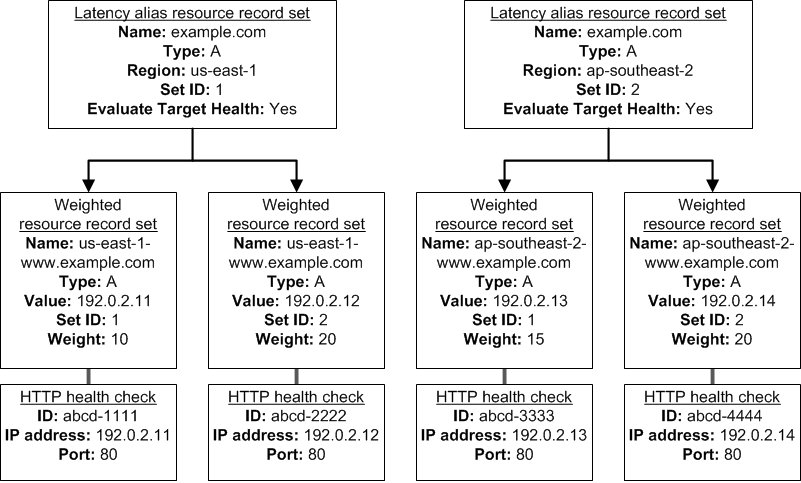
Here's how Amazon EC2 and Amazon Route 53 are configured:
You have Amazon EC2 instances in two regions, us-east-1 and ap-southeast-2. You want Amazon Route 53 to respond to queries by using the resource record sets in the region that provides the lowest latency for your customers, so you create a latency alias resource record set for each region. (You create the latency alias resource record sets after you create resource record sets for the individual Amazon EC2 instances.)
Within each region, you have two Amazon EC2 instances. You create a weighted resource record set for each instance. The name and the type are the same for both of the weighted resource record sets in each region.
When you have multiple resources in a region, you can create weighted or failover resource record sets for your resources. You can also create even more complex configurations by creating weighted alias or failover alias resource record sets that, in turn, refer to multiple resources.
Each weighted resource record set has an associated health check. The IP address for each health check matches the IP address for the corresponding resource record set. This isn't required, but it's the most common configuration.
For both latency alias resource record sets, you set the value of Evaluate Target Health to Yes.
You use the Evaluate Target Health setting for each latency alias resource record set to make Amazon Route 53 evaluate the health of the alias targetsג€"the weighted resource record setsג€"and respond accordingly.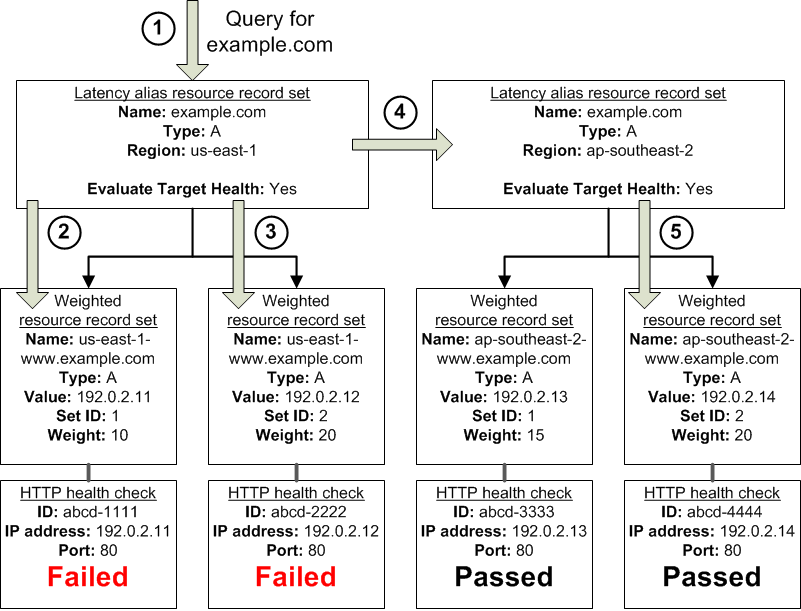
The preceding diagram illustrates the following sequence of events:
Amazon Route 53 receives a query for example.com. Based on the latency for the user making the request, Amazon Route 53 selects the latency alias resource record set for the us-east-1 region.
Amazon Route 53 selects a weighted resource record set based on weight. Evaluate Target Health is Yes for the latency alias resource record set, so Amazon
Route 53 checks the health of the selected weighted resource record set.
The health check failed, so Amazon Route 53 chooses another weighted resource record set based on weight and checks its health. That resource record set also is unhealthy.
Amazon Route 53 backs out of that branch of the tree, looks for the latency alias resource record set with the next-best latency, and chooses the resource record set for ap-southeast-2.
Amazon Route 53 again selects a resource record set based on weight, and then checks the health of the selected resource record set. The health check passed, so Amazon Route 53 returns the applicable value in response to the query.
What Happens When You Associate a Health Check with an Alias Resource Record Set?
You can associate a health check with an alias resource record set instead of or in addition to setting the value of Evaluate Target Health to Yes. However, it's generally more useful if Amazon Route 53 responds to queries based on the health of the underlying resourcesג€"the HTTP servers, database servers, and other resources that your alias resource record sets refer to. For example, suppose the following configuration:
You assign a health check to a latency alias resource record set for which the alias target is a group of weighted resource record sets.
You set the value of Evaluate Target Health to Yes for the latency alias resource record set.
In this configuration, both of the following must be true before Amazon Route 53 will return the applicable value for a weighted resource record set:
The health check associated with the latency alias resource record set must pass.
At least one weighted resource record set must be considered healthy, either because it's associated with a health check that passes or because it's not associated with a health check. In the latter case, Amazon Route 53 always considers the weighted resource record set healthy.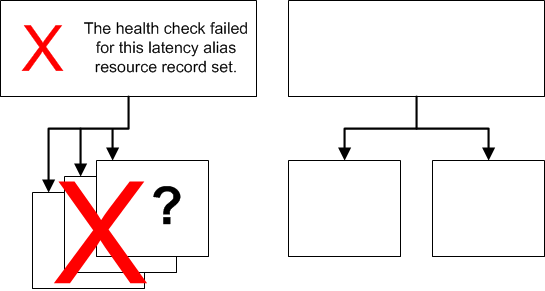
If the health check for the latency alias resource record set fails, Amazon Route 53 stops responding to queries using any of the weighted resource record sets in the alias target, even if they're all healthy. Amazon Route 53 doesn't know the status of the weighted resource record sets because it never looks past the failed health check on the alias resource record set.
What Happens When You Omit Health Checks?
In a complex configuration, it's important to associate health checks with all of the non-alias resource record sets. Let's return to the preceding example, but assume that a health check is missing on one of the weighted resource record sets in the us-east-1 region: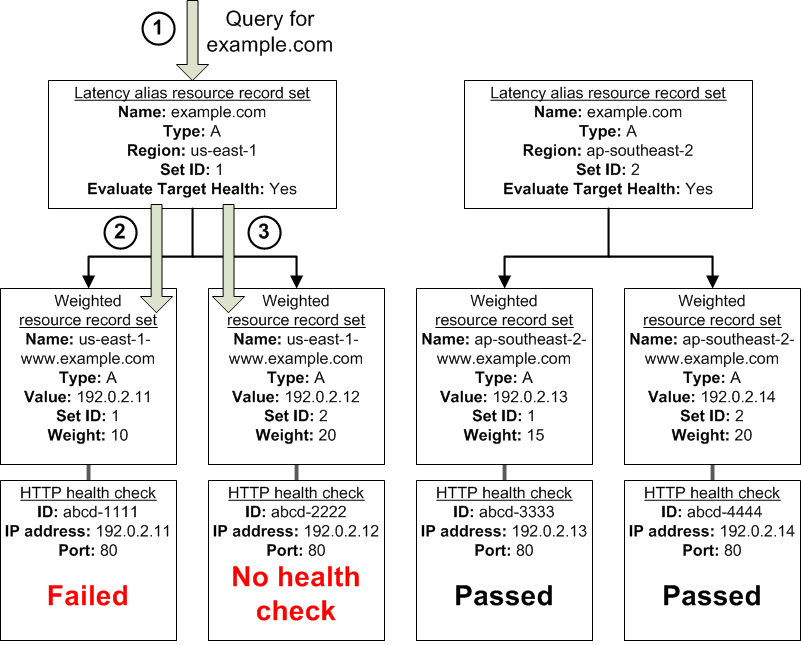
Here's what happens when you omit a health check on a non-alias resource record set in this configuration:
Amazon Route 53 receives a query for example.com. Based on the latency for the user making the request, Amazon Route 53 selects the latency alias resource record set for the us-east-1 region.
Amazon Route 53 looks up the alias target for the latency alias resource record set, and checks the status of the corresponding health checks. The health check for one weighted resource record set failed, so that resource record set is omitted from consideration.
The other weighted resource record set in the alias target for the us-east-1 region has no health check. The corresponding resource might or might not be healthy, but without a health check, Amazon Route 53 has no way to know. Amazon Route 53 assumes that the resource is healthy and returns the applicable value in response to the query.
What Happens When You Set Evaluate Target Health to No?
In general, you also want to set Evaluate Target Health to Yes for all of the alias resource record sets. In the following example, all of the weighted resource record sets have associated health checks, but Evaluate Target Health is set to No for the latency alias resource record set for the us-east-1 region: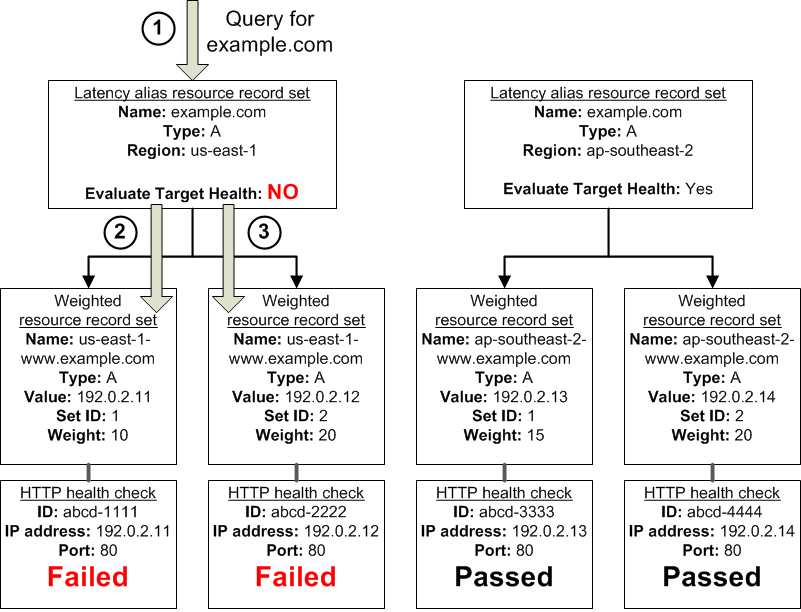
Here's what happens when you set Evaluate Target Health to No for an alias resource record set in this configuration:
Amazon Route 53 receives a query for example.com. Based on the latency for the user making the request, Amazon Route 53 selects the latency alias resource record set for the us-east-1 region.
Amazon Route 53 determines what the alias target is for the latency alias resource record set, and checks the corresponding health checks. They're both failing.
Because the value of Evaluate Target Health is No for the latency alias resource record set for the us-east-1 region, Amazon Route 53 must choose one resource record set in this branch instead of backing out of the branch and looking for a healthy resource record set in the ap-southeast-2 region.